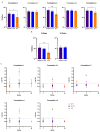Intranasally Delivered Adenoviral Vector Protects Chickens against Newcastle Disease Virus: Vaccine Manufacturing and Stability Assessments for Liquid and Lyophilized Formulations
- PMID: 38250854
- PMCID: PMC10819614
- DOI: 10.3390/vaccines12010041
Intranasally Delivered Adenoviral Vector Protects Chickens against Newcastle Disease Virus: Vaccine Manufacturing and Stability Assessments for Liquid and Lyophilized Formulations
Abstract
Newcastle disease (ND) remains a critical disease affecting poultry in sub-Saharan Africa. In some countries, repeated outbreaks have a major impact on local economies and food security. Recently, we developed an adenovirus-vectored vaccine encoding the Fusion protein from an Ethiopian isolate of Newcastle disease virus (NDV). The adenoviral vector was designed, and a manufacturing process was developed in the context of the Livestock Vaccine Innovation Fund initiative funded by the International Development Research Centre (IDRC) of Canada. The industrially relevant recombinant vaccine technology platform is being transferred to the National Veterinary Institute (Ethiopia) for veterinary applications. Here, a manufacturing process using HEK293SF suspension cells cultured in stirred-tank bioreactors for the vaccine production is proposed. Taking into consideration supply chain limitations, options for serum-free media selection were evaluated. A streamlined downstream process including a filtration, an ultrafiltration, and a concentration step was developed. With high volumetric yields (infectious titers up to 5 × 109 TCID50/mL) in the culture supernatant, the final formulations were prepared at 1010 TCID50/mL, either in liquid or lyophilized forms. The liquid formulation was suitable and safe for mucosal vaccination and was stable for 1 week at 37 °C. Both the liquid and lyophilized formulations were stable after 6 months of storage at 4 °C. We demonstrate that the instillation of the adenoviral vector through the nasal cavity can confer protection to chickens against a lethal challenge with NDV. Overall, a manufacturing process for the adenovirus-vectored vaccine was developed, and protective doses were determined using a convenient route of delivery. Formulation and storage conditions were established, and quality control protocols were implemented.
Keywords: HEK293 suspension cells; adenovirus vaccine; bioreactor production; downstream processing; intranasal vaccination; mucosal protection; newcastle disease virus; vaccine manufacturing; veterinary vaccine production platform.
Conflict of interest statement
The authors declare no conflicts of interest.
Figures







References
-
- Grace D., Roesel K., Lore T. Poverty and Gender Aspects of Food Safety and Informal Markets in Sub-Saharan Africa. ILRI (aka ILCA and ILRAD); Nairobi, Kenya: 2014.
-
- Wilson R.T. Poultry production and performance in the Federal Democratic Republic of Ethiopia. World Poult. Sci. J. 2010;66:441–454. doi: 10.1017/S0043933910000528. - DOI
Grants and funding
LinkOut - more resources
Full Text Sources

